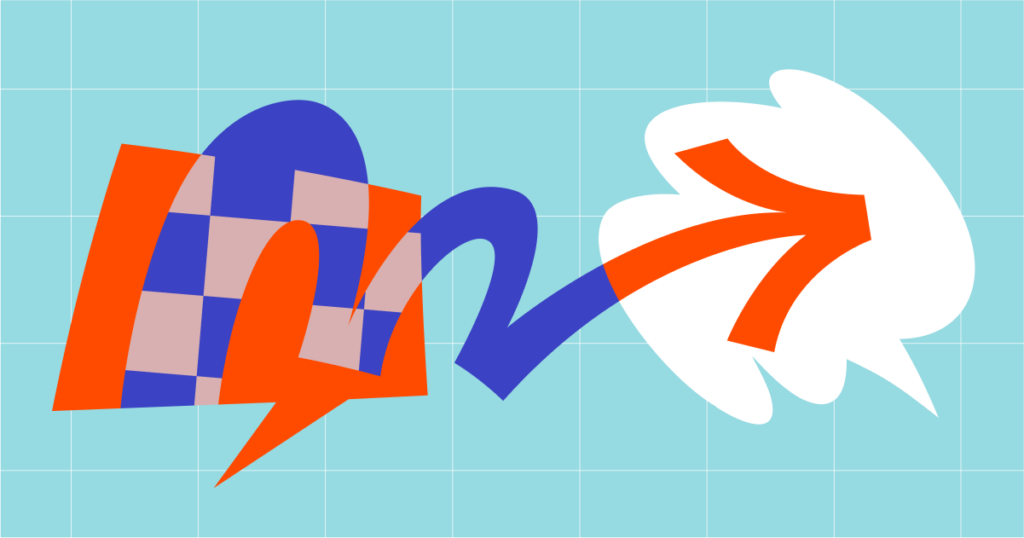Foi um verão intenso de IA, em parte por causa das promessas que a tecnologia oferece: automatizar os aspectos mais chatos do trabalho, liberando mais tempo para que as pessoas possam se envolver em questões de maior significado. Essa é também a promessa da automação no Instagram como parte de uma estratégia mais ampla de marketing digital.
Criadores lutam para equilibrar várias demandas, especialmente quando a atuação no Instagram ainda não é o seu trabalho ‘principal’. É difícil acompanhar concorrentes, tendências e um algoritmo que está sempre mudando. O desgaste de tempo e recursos também acaba afetando a sua criatividade.
Para alcançar o sucesso, é preciso trabalhar de forma inteligente — como identificar partes da sua estratégia de marketing digital que podem ser automatizadas. Vamos falar um pouco sobre esse cenário, que ainda tem muito a crescer, passando pelo que é possível fazer hoje e as promessas futuras da automação no Instagram.
Antes de mais nada, vamos olhar para a nossa bola de cristal.

O Que Queremos Dizer com Automação?
A automação já está integrada em diversos aspectos das nossas vidas diárias: termostatos inteligentes, respostas automáticas de e-mail, carros autônomos que estão sempre a cinco anos de se tornarem totalmente autônomos e resolverem o trânsito para sempre (sonhar não custa nada).
Automação é uma tecnologia (normalmente ferramentas de terceiros ou um software construído sobre APIs disponíveis; vamos falar mais sobre isso depois) que realiza tarefas tediosas e repetitivas por nós. Essa tecnologia está cada vez melhor e assumindo tarefas cada vez mais sofisticadas. A automação responsável ajuda marcas a otimizar e simplificar seus esforços de marketing digital, desde campanhas de e-mail até a presença nas redes sociais.
Automação no Instagram
Isso nos leva à automação no Instagram. Gerenciar e expandir uma conta de Instagram bem-sucedida com um público altamente engajado requer tempo e energia. Colocar alguns aspectos desse trabalho no piloto automático permite que os criadores se concentrarem no que tem mais impacto para seus negócios.
Você já pode automatizar algumas rotinas do Instagram com as quais a maioria dos usuários já está familiarizada, como gerenciamento e publicação de conteúdo:
- Agendamento de postagens: ferramentas que lidam com tarefas como agendamento e filas de conteúdo existem há tanto tempo que a maioria dos criadores nem sequer as considera como uma automação; o mesmo vale para a possibilidade de publicar conteúdo em várias plataformas.
- Engajamento de postagens: curtir e comentar em postagens, responder a comentários e DMs (aqui a maioria já passou por maus bocados com os bots; vamos falar sobre isso mais adiante).
- Engajamento de seguidores: seguir e deixar de seguir contas com base em certos critérios e remover seguidores inativos (ou, ironicamente, bots).
- Criação de conteúdo: graças às ferramentas de IA é possível criar ou melhorar imagens e vídeos com base em comandos, além de escrever legendas e sugerir hashtags.
- Pesquisa e relatórios: algumas ferramentas podem gerar relatórios automáticos sobre o desempenho de conteúdo, enquanto outras conseguem realizar pesquisas sobre hashtags e concorrentes (a profundidade depende do seu orçamento).
- Gestão de concursos e campanhas publicitárias: as ferramentas também podem ajudar a administrar um concurso ou direcionar anúncios com base em dados de desempenho (isso está disponível de forma nativa através dos anúncios do Instagram).
- Outreach de influenciadores: outras ferramentas podem ajudar a alcançar influenciadores para parcerias com base em critérios específicos.
Dependendo dos objetivos para a presença da sua marca no Instagram — e do seu orçamento de marketing digital — você pode automatizar algumas ou todas essas tarefas. É preciso ter cuidado com o excesso de automação, já que respostas genéricas a comentários ou DMs são facilmente percebidas como “spam” pelo público. Uma vez que você ganha essa reputação, é preciso muito trabalho braçal para reconquistar seu público, jogando por água abaixo todo aquele tempo que você economizou com o uso da automação.
Também é importante lembrar que, embora algumas dessas ações sejam possíveis por meio de ferramentas de terceiros, elas também podem violar o que é oficialmente permitido através das APIs do Instagram. Ferramentas criadas para automação de seguir e deixar de seguir, curtir e comentar (em postagens que não são suas) e enviar DMs que não sejam casos de uso aprovados para empresas são exemplos de violação. Elas correm o risco de serem encerradas — e levar todos os seus dados junto.
Políticas de Automação do Instagram
Embora você possa automatizar uma diversas atividades no Instagram, não quer dizer que você deva — especialmente se isso violar as políticas do Instagram, incluindo seus Termos de Uso e o que é permitido através de suas APIs. A automação não autorizada (como chatbots fingindo ser humanos) é explicitamente proibida.
As APIs do Instagram também restringem a automação de certas atividades para evitar a geração de spam e preservar uma melhor experiência do usuário. Elas não permitem a automação das seguintes funções:
- Seguir ou deixar de seguir
- Curtir ou comentar
- Enviar DMs (exceto para casos de uso aprovados para empresas)
Elas também não permitem a extração de dados de usuários além do que é explicitamente fornecido pela API na forma de informações básicas de perfil, fotos e vídeos. Quaisquer aplicativos ou ferramentas de terceiros construídos nas APIs do Instagram também estão sujeitos a limites de taxa (o número de solicitações ou ações que você pode realizar em um determinado período), aprovações e outras restrições. Os dados disponíveis por meio de uma API podem mudar a qualquer momento.
As APIs permitem:
- Agendamento e publicação de postagens
- Recuperação de análises e insights
- Gerenciamento de comentários (recuperação, resposta, ocultação e exclusão)
- Pesquisa de conteúdo público por hashtag (com limitações)
- Gerenciamento de perfis e catálogos de negócios
O mais importante é encontrar um conjunto de ferramentas respeitáveis que ajudem a automatizar a presença da sua marca de forma impactante, liberando seu tempo para fazer um trabalho de criação, algo que os robôs nunca vão acertar completamente. As Automations do Instagram da Manychat são apenas uma opção a explorar (e somos um Parceiro de Negócios aprovado pelo Facebook (agora Meta), então você não precisa se preocupar com possíveis violações de regras).

O Que a Automação do Instagram Pode Fazer por Você e Seu Negócio
A automação bem feita simplifica seu negócio, e o Instagram é o lugar perfeito para começar. Ela ajuda a impulsionar seu negócio melhorando:
Eficiência: economize tempo agendando conteúdo em lotes e automatizando tarefas repetitivas, como responder a perguntas comuns nas DMs com respostas personalizadas e alinhadas à sua marca.
Consistência: lotes e agendamentos de conteúdo significam que seu público sabe quando esperar atualizações no seu perfil, e a voz da sua marca permanece consistente nas suas postagens (pontos extras para reaproveitamento entre plataformas!).
Alcance: postagens cruzadas e uso de hashtags sugeridas automaticamente ajudam a expandir seu público de forma direcionada.
Engajamento: os clientes não precisam esperar tanto por uma resposta nas suas DMs ou comentários, enquanto menções recebem reações imediatas, solidificando a lealdade à marca e aumentando a probabilidade de que os seguidores voltem a interagir e compartilhar seu conteúdo no futuro.
Gestão de campanhas: desde campanhas orgânicas até anúncios, automatizar alguns aspectos ajuda a tornar o trabalho mais leve, para que você possa fazer mais.
Estratégia de conteúdo: desde saber quando postar até como seu público está reagindo ao seu conteúdo, automatizar postagens e geração de relatórios ajuda a alinhar os fluxos de trabalho.
Segurança da marca: a automação tem papel importante na moderação de conteúdo, como a filtragem automática de comentários inadequados.
Tudo isso dá a você tempo para se concentrar no que é mais importante, como pensar em novos conteúdos e focar em outros aspectos da administração da sua marca que impactam seu resultado final. A automação também ajuda a escalar seu negócio e se manter em pé de igualdade com os concorrentes que usam a mesma tecnologia.
Mas cuidado para não depender demais dela — ou você corre o risco de afastar o seu público pela falta de autenticidade.

Atenção: Riscos Potenciais e Desafios da Automação no Instagram
O maior erro que os criadores podem cometer com a automação é automatizar demais e perder o elemento humano, item crucial quando o assunto é presença social. Uma coisa é parecer polido e responsivo; outra é parecer frio, robótico ou até mesmo spam. O público quer autenticidade.
O maior valor está em encontrar um equilíbrio que libere seu tempo para um trabalho mais estratégico e criativo, enquanto mantém uma conexão real com seu público. Uma vez que você perde o respeito do seu público, é extremamente difícil reconquistá-lo. A reputação da sua marca sofre um grande golpe, resultando em perda de negócios e de público.
A dependência excessiva da automação também pode sinalizar que sua marca está dando um passo maior do que a perna. Nessas horas, é importante reavaliar seus objetivos e recursos, e realinhar sua estratégia e abordagem.

Melhores Práticas: Acertando na Automação do Instagram
Escolha quais tarefas você vai automatizar e quais você ainda fará manualmente. Comece com a lista de verificação de melhores práticas abaixo e ajuste sua estratégia com base no que faz mais sentido para o seu negócio no estágio atual:
- Use ferramentas de automação aprovadas: desconfie de qualquer ferramenta que ofereça serviços que violem os Termos de Uso do Instagram ou qualquer coisa explicitamente proibida pelas APIs do Instagram.
- Foque na qualidade em vez da quantidade: automatize as tarefas mais tediosas e use seu tempo para um trabalho mais criativo e impactante.
- Automatize os números: análises, relatórios e muito mais; o investimento em anúncios é algo que pode fazer a diferença com a automação, tanto em termos de desempenho dos seus anúncios quanto dos seus recursos!
- Aposte em testes A/B: como parte da sua estratégia de conteúdo, investa em testes automáticos de duas versões diferentes de conteúdo (pago ou orgânico) para ver qual performa melhor. Use os resultados para guiar as suas próximas ações.
- Fique antenado e siga as regulamentações: esteja sempre atento às atualizações do Instagram (e neste blog) para ter certeza de que está trabalhando de acordo com as regras e regulamentações mais recentes.
- Use a automação com responsabilidade: evite automatizar tudo só porque é possível. Escolha com sabedoria e deixe suas mensagens o mais personalizadas e alinhadas à marca quanto possível.
Por exemplo, você pode começar a automação no Instagram nas DMs para alguns tipos de perguntas frequentes e responder pessoalmente quando perceber que as respostas automáticas chegaram no limite.
Você também pode desenvolver respostas altamente personalizadas para comentários ou DMs, mostrando para a sua audiência que, mesmo ocupado, você os conhece bem o suficiente para criar uma mensagem de impacto e que os ajude a lembrar por que se engajam na sua marca.
É importante acompanhar as respostas a qualquer automação implementada e usar esse feedback para ajustar a sua estratégia de forma contínua. Às vezes, tudo o que você precisa é de um pequeno ajuste na linguagem usada nas suas respostas automatizadas para obter mais resultados. Outras vezes, pode ficar claro que você automatizou ainda precisa ser feito manualmente.
Contanto que você se mantenha atento ao feedback, isso não deve se transformar em um problema para a sua marca.

De Olho no Futuro: Tendências para a Automação no Instagram
Ainda que o futuro possa parecer nebuloso, é possível fazer algumas suposições com base no que sabemos sobre o que está por vir na automação do Instagram.
Integrações entre IA e Machine Learning
Para tristeza dos fãs da Skynet, criar uma inteligência artificial no mesmo nível do cérebro humano ainda não é possível, mas a tecnologia deve seguir evoluindo à medida que os especialistas aprimoram os dados de treinamento e os modelos usados para desenvolver os grandes modelos de linguagem (LLMs) que formam os sistemas de IA que já conhecemos.
No caso da automação do Instagram, isso pode significar ferramentas de edição aprimoradas para imagens e vídeos, sugestões de legendas e hashtags, ou até dicas sobre o formato ideal para cada tipo de conteúdo (Reels vs. Stories, por exemplo). Os fãs da Realidade Aumentada (AR) também podem contar com sugestões de filtros e efeitos.
Avanços mais sofisticados podem incluir respostas automatizadas personalizadas em comentários e DMs, com base no comportamento e histórico dos usuários (seguindo os casos de uso aprovados, naturalmente). Também pode ser que que vejamos critérios mais complexos para conectar marcas a influenciadores, além de uma moderação de conteúdo automatizada em tempo real.
Análises Avançadas e Modelagem Preditiva
Os robôs são excelentes quando o assunto é análise e modelagem de dados. Avanços na IA podem trazer melhorias significativas nas previsões de tendências e assuntos antes que eles atinjam o auge, permitindo que os criadores ajustem suas estratégias de conteúdo em tempo real, mantendo o conteúdo alinhado à marca e ao público.
Os modelos também podem indicar os melhores horários e tipos de conteúdo para postar, com base em combinações mais sofisticadas de análise de público, sazonalidade e comportamento passado. A análise de sentimentos ainda é um desafio para a tecnologia, já que os robôs tendem a não captar sutilezas como sarcasmo, hipérboles ou outras figuras de linguagem. Melhorias no processamento de linguagem natural (NLP) podem facilitar isso, permitindo que os criadores entendam rapidamente como o público se sente de fato em relação ao conteúdo.

O Futuro Promissor da Automação na Instagram
O pior cenário seria todo mundo automatizando completamente todas as ações possíveis no Instagram, transformando a plataforma em um deserto de bots que passam o dia “conversando” entre si. Felizmente, esse tipo de comportamento já é proibido pelas APIs oficiais da plataforma. À medida que a tecnologia avança para tentar contornar as regras, ela também evolui para combater os infratores.
A verdade é que a automação não é algo ruim; a automação irresponsável é que resulta em uma experiência ruim para os usuários. Experiências ruins afastam fãs, seguidores e potenciais clientes, reduzindo seu público e limitando o potencial do seu negócio.
Automatizar de forma inteligente torna seus esforços de marketing digital mais eficientes, ao mesmo tempo em que permite que o elemento humano brilhe — criando conexões autênticas com seu público.
Quer saber mais sobre as capacidades de automação do Instagram da Manychat hoje e no futuro? Participe do nosso Instagram Summit em outubro!







